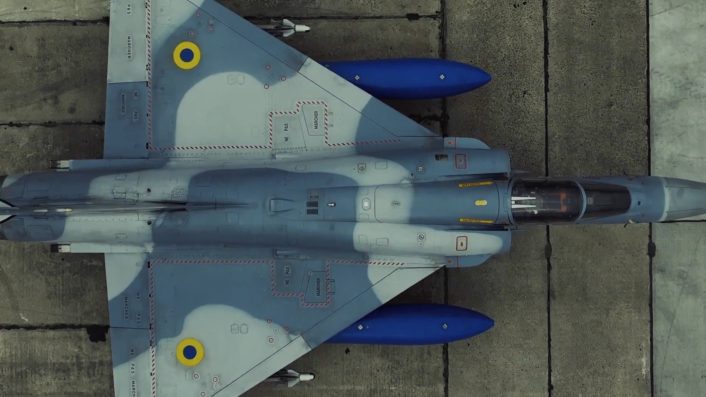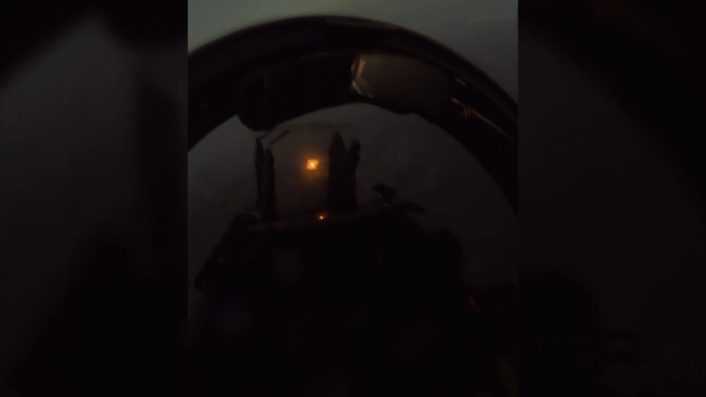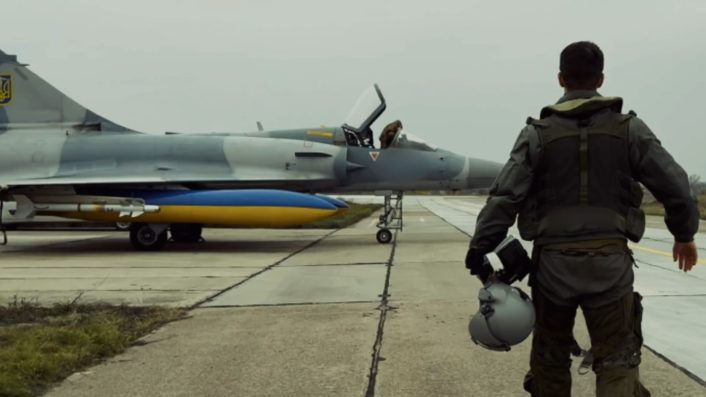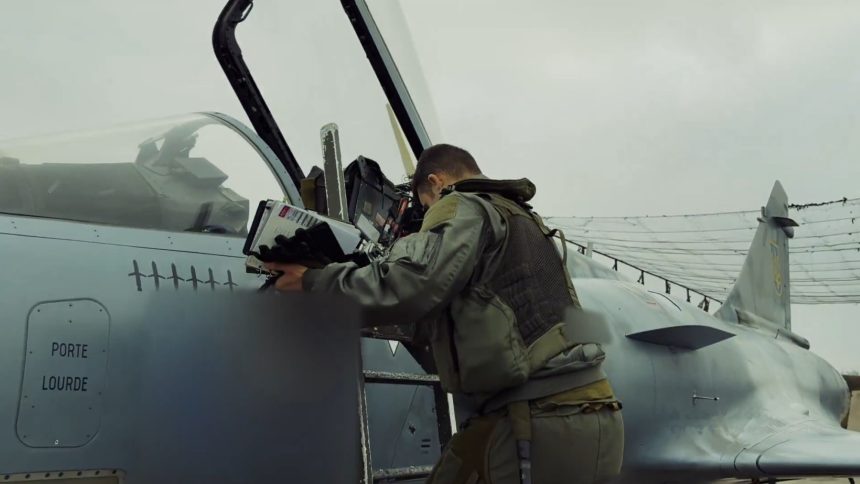A Ukrainian Mirage 2000-5F was shown with six Kh-101 ALCM kill markings in a rare close-up look at the French-supplied jet delivered earlier this year.
A Ukrainian Air Force (UKrAF) French-made Mirage 2000-5F has been spotted with kill marks of what resemble Russian Kh-101 (X-101) long-range ALCM (Air-Launched Cruise Missile) in a Nov. 17, 2025, promotional video about the fighter. The country is currently believed to operate six of them, transferred by France earlier this year.
There are six missile shapes visible below the cockpit’s canopy rail on the port side of the jet. The video by the UKrAF also shows the aircraft carrying one R550 Magic Matra short-range air-to-air missile (SRAAM) on each of the wings, along with two external fuel tanks, as well as the engagement of a target in low-light hours.
✈️ Mirage 2000 of the Ukrainian Air Force flies on a combat mission, awaiting good news from France.
Ukraine🤝France
🇺🇦 Together to Victory! pic.twitter.com/edlm8FtIuf
— Ukrainian Air Force (@KpsZSU) November 17, 2025
It is not clear if this target was a Kh-101 – versions of which have appeared over the last two years with dual/penetrating warheads and dispensing flares/decoys to deceive air defense missiles – or a Shahed-type Russian Geran-2 kamikaze drone. Similarly, it is not clear when the engagement took place.

The use of Mirage 2000s to engage cruise missiles cannot be denied, as the service previously published a video of the interception of such weapons shortly after the French fighter was delivered. The service had also publicized in September its F-16s engaging Russian aerial targets with AIM-9M Sidewinder SRAAMs, with footage from inside the F-16s themselves and HUD (Heads-Up Display) recordings showing the AIM-9 hitting the target.
Footage published today by the Ukrainian Air Force showing a French-supplied Mirage 2000-5F with six kill marks for Russian cruise missiles, likely Kh-101s downed during missions over Ukraine. pic.twitter.com/i1vggw6OkM
— OSINTdefender (@sentdefender) November 17, 2025
In the past, the Ukrainian military has officially identified in infographics the Kh-101 as one the targets being shot down, and both the designs in these illustrations and the kill marks point to the Kh-101, the leading Russian ALCM.
Russia has modified the Kh-101 cruise missile to carry a second 350 kg warhead.
To add the extra mass to the main 450kg warhead the fuel tank has been reduced, halving its original 5500km range but still allowing access to all of Ukraine. pic.twitter.com/B1ayLQfagQ
— Roy🇨🇦 (@GrandpaRoy2) May 9, 2024
Ukraine’s signing of a Letter of Intent with France for potential supply of up to 100 Rafales, SAMP/T surface-to-air missile batteries, more SCALP missiles, AASM Hammer guided bombs and Gripens from Sweden signals how the country is gearing up to rearm and rebuild its military as the conflict progresses.

Neither Russia or Ukraine achieved air superiority, but, with high numbers of modern systems, the air war might likely shift in Kyiv’s favor over the next few years – assuming the conflict lasts that long. That outcome would be decided by a series of diplomatic invariables, as the international community pushes to end the war.
On the night of September 20, Russia launched a massive combined strike against Ukraine, using 619 aerial targets:
•579 Shahed attack drones and decoys;
•8 Iskander-M/KN-23 ballistic missiles;
•32 Kh-101 cruise missiles.
⚡️ By 09:00, Ukrainian air defense shot down/suppressed… pic.twitter.com/NSHUOpwPJZ
— Special Kherson Cat 🐈🇺🇦 (@bayraktar_1love) September 20, 2025
Russian standoff missiles
It is unlikely that F-16s and Mirages would be used to fire at slower and simpler targets like UAVs, given the lessons learnt over two years with Russian standoff strikes, meant to expend Ukraine’s Western air defenses, and the experience with the Houthis and Iran. The drones are currently being engaged by helicopters with door-mounted guns and classic machine gun air defenses on the ground.
The propeller-driven drones themselves would also have no useful heat trace for the infrared seekers of the AIM-9 and the R550.
Russia periodically conducts coordinated mass ALCM, Iskander, Geran-2 and sea-launched 3M54-1 Kalibr attacks across the entire front. These include targets both deep into Ukrainian cities and towns, sometimes reaching as far as the country’s west. Russia’s MoD frequently describes these targets as “civilian-military” locations supporting Moscow’s stated objectives of “demilitarization” of Ukraine.

Russia’s Tu-160s, Tu-22M3 and Tu-95s are able to carry the Kh-101, the Russian equivalent of the U.S. AGM-158 JASSM, or the British/French Storm Shadow/SCALP-EG. These are not fired singularly and have largely been synchronized with Geran, Iskander and Kalibrs from the Black Sea, overwhelming Ukrainian command and control planning across the entire 600 km front.
Shootdowns vs stockpiles
Rising levels of shoot downs, as the UKrAF said when it released the F-16 videos in September, do not make a difference to a discerning observer of military tactics. Nearly all weapons used to shoot them down come from U.S. and European countries’ own stockpiles.
The UKrAF had said on Sep. 20 that the “massive combined strike” by Russia involved “619 aerial targets,” including 579 Shahed attack drones and decoys; 8 Iskander-M/KN-23 ballistic missiles; and 32 Kh-101 cruise missiles. Of these, the Ukrainians downed 583, including 552 Shahed drones/decoys; 2 Iskander-M (or possibly a North Korean KN-23; and 29 Kh-101s.

Delays in replenishment due to diplomatic hurdles are exploited by Russia to make strategic gains on the battlefield – albeit at sometimes great, painful tactical cost. This represents a fundamental clash in Western and Eastern military doctrines, putting fast-paced, high-intensity military operations against longer, sustained wars.
Overnight, Russia attacked Ukraine with both missiles and drones.
Shot down:
0/2 Kh-47M2 Kinzhal aeroballistic
12/12 Kh-101/555 cruise missile
31/31 Shahed kamikaze drones. pic.twitter.com/j8yzuasugd
— NOELREPORTS 🇪🇺 🇺🇦 (@NOELreports) May 26, 2024
Regarding the Mirage 2000s engaging Russian missiles, these missiles could be among the 14 out of the 19 President Volodymyr Zelenskyy said on Nov. 14 were shot down by the Ukrainian military while they were targeting “residential areas of Kyiv and energy infrastructure.” Given two Western reports this year of the alarming rate with which anti-air missiles’ stocks are being depleted, any other such reports in the future, especially following a series of Russian standoff strikes, will indicate the direction of these dynamics.









